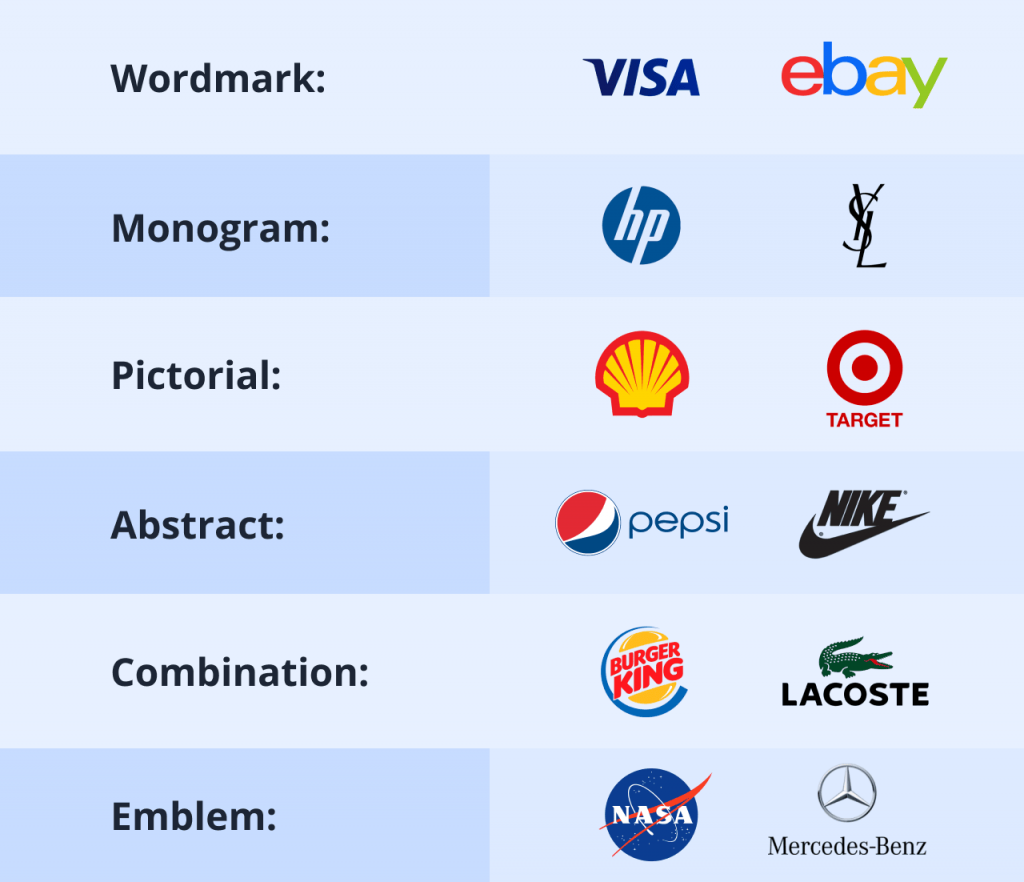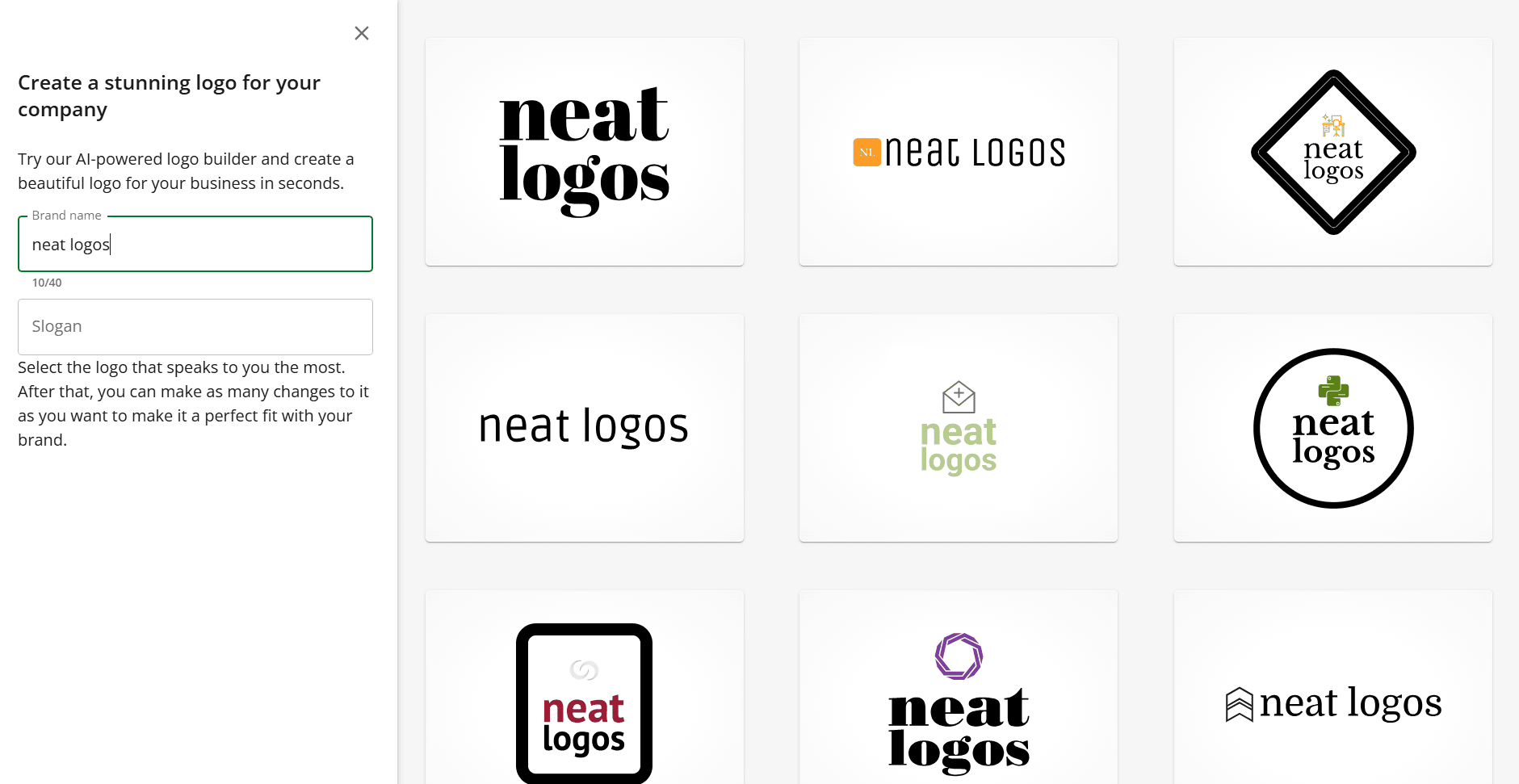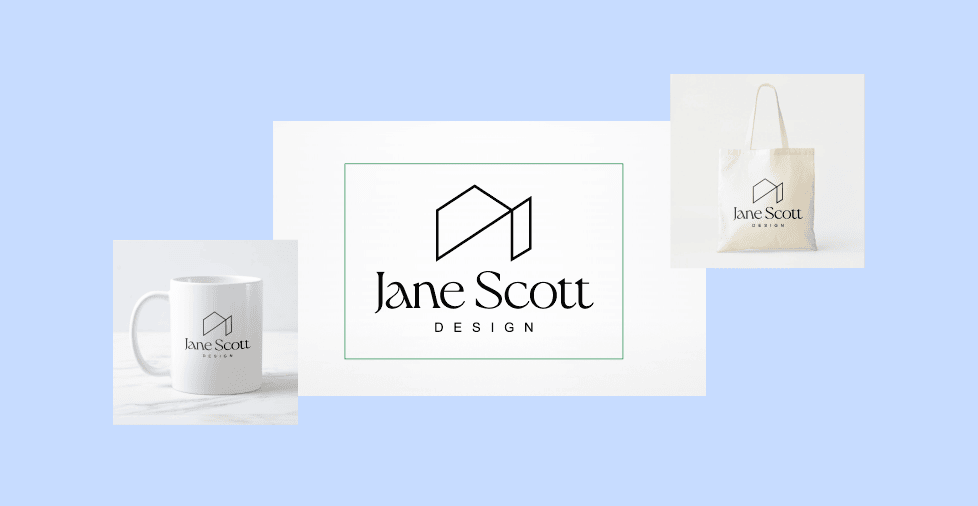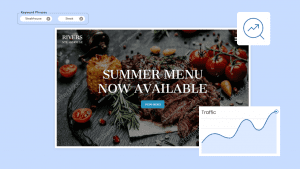Key takeaways:
- A good logo makes your business easily recognizable and shapes how people see your brand.
- Impactful logos start with a clear brand identity. Before designing, know what your business stands for and who you’re targeting.
- There are different types of logos, and each sends a different message.
Your logo is often your business’s first impression, especially in today’s crowded online space. Every detail sends a message about who you are, from the colors you pick to the typeface you choose.
Consider Nike’s simple swoosh or Apple’s minimalist icon—both instantly recognizable, even without their brand names attached.
Want to learn how to create a logo that customers will remember? Let’s walk through it step-by-step.
What is a logo?
At its core, a logo is a visual symbol that represents your business. It usually combines text, images, or both, and people instantly recognize and associate with your company.
Think of it as your brand’s visual signature. A good logo helps your audience identify your products, website, or social media channel at a glance, setting you apart from competitors.
Logos come in different styles and shapes, from simple wordmarks like Google’s colorful lettering, to iconic images like Twitter’s bird. But regardless of style, the purpose is the same: to give your business an easily recognizable visual identity.
Why do you need a logo?
A logo gives your business an identity and makes it easy to recognize. You should put your logo on all your branding materials so it’s easy for your customers to remember who you are.
Your logo needs to be great. It should have the power to communicate what you stand for while leaving a lasting impression on your customers.
How to design a logo
Designing a great logo is a challenge, but with resourcefulness and patience, you can create a logo that matches your vision, even if you’re a beginner. Follow these steps to guide your ideas, stay organized, and design a logo you’re proud to show off.
- Define your brand identity
- Find inspiration and brainstorm ideas
- Determine the logo type
- Pick a font and color palette
- Create your first iterations
- Test your design and refine
- Finalize the design and put it to work
Define your brand identity
Before you think about fonts or icons, you need to understand what your brand stands for. Your logo should reflect the personality and purpose of your business, so the first step is getting clear on what that is.
Start by asking yourself:
- What does my business do?
- What kind of feeling do I want people to get when they see my brand?
- What values or qualities do I want my brand to be known for?
These questions might sound simple, but your answers will guide every creative decision. A playful children’s brand will look very different from a high-end law firm, even if both are equally thoughtful in their design.
Find inspiration and brainstorm ideas
Once you fully grasp your brand’s identity, it’s time to brainstorm ideas that align with it. Find inspiration from your competitors or other brands whose logos resonate with you.
Browse design websites like Pinterest, Behance, or Dribbble and note symbols, patterns, or colors you naturally feel drawn to. Follow design trends and mentally map how you can apply them to your logo to make it more relevant.
This stage is all about exploration. Save images, sketch rough ideas, or jot down words that capture your brand’s personality. Think of it as building a creative mood board. The goal is to collect sparks that you can shape into a visual direction in the next steps.
If you’re stuck and having trouble coming up with ideas, you can use free logo makers to jumpstart your imagination. Network Solutions’ Website Builder tool has a free logo maker that allows you to generate logos using your brand name. It’s a good way to start your creation process, slowly building into your envisioned design.
Determine the logo type
Exploring the different logo types can help you get closer to your ideal design. Each type has its visual impact that reinforces your identity.
- Wordmark
- Monogram
- Pictorial mark
- Abstract mark
- Combination mark
- Emblem
Take a look at the examples of each type and think about what fits your brand and the best way to represent it visually.

- Wordmark. A logo built entirely from your business name. Think of Visa or eBay. Wordmarks work well when building name recognition, especially if your brand name is short and memorable.
- Monogram. A logo made from initials, like HP (Hewlett-Packard) or YSL (Yves Saint Laurent). It’s great for brands with long or multi-word names and simplifies your brand visually while still keeping it recognizable.
- Pictorial mark. A symbol or icon, like Shell’s shell icon or Target’s bullseye. It’s simple but powerful. A pictorial mark relies on strong visual memory, which means it’s effective after your brand becomes more familiar to people.
- Abstract mark. Unlike pictorial logos, these don’t represent real-world objects. Think of Pepsi’s swirl or Nike’s swoosh. Abstract marks let you shape a unique visual identity that’s open to interpretation and often more versatile.
- Combination mark. A blend of text and icon. For example, Burger King or Lacoste. This type offers flexibility—you can use the icon, text, or both, depending on where the logo appears.
- Emblem. Text enclosed within a shape or symbol, like badges or crests. Schools, government agencies, or traditional brands commonly use emblems. Emblems give a classic, established feel, but can be harder to scale for smaller spaces.
Pick a font and color palette
The font and colors you choose greatly influence how people feel about your brand at first glance. Consider what you want people to feel when they see your logo and choose the elements that help send that message.
Fonts can make your brand look friendly, professional, playful, or bold. For example:
- A clean, modern sans-serif font can feel approachable and tech-savvy.
- A serif font with decorative strokes might give your brand a more classic or elegant tone.
- Handwritten or script fonts can add a personal, creative touch.
Before choosing colors, explore basic color theory and color psychology. This can help you understand how different colors work together and how they influence emotion and perception:
- Blue often feels trustworthy and calm.
- Red is energetic and attention-grabbing.
- Green often signals growth, health, or sustainability.
- Black or dark gray can feel strong and luxurious.
Besides color theory and psychology, be mindful of your design’s contrast and legibility. Your logo should still be recognizable in black and white or scaled down for a small screen.
Create your first iterations
Once you’ve chosen a direction for your font, color, and logo type, it’s time to bring your ideas to life. Don’t aim for perfection yet. This stage is all about trying different things and seeing what sticks.
Start by sketching rough versions of your logo. You can use pen and paper, a free design tool, or even a logo maker to test shapes and layouts. Focus on different ways to arrange your text and icon. Try mixing and matching elements. Perhaps your wordmark works better with a bolder font, or your symbol needs plenty of space.
Also, be mindful of the shapes you use, as they convey different emotions in design:
- Circles often feel friendly, inclusive, and harmonious.
- Squares and rectangles suggest stability and reliability.
- Triangles can convey energy, stability, or power.
- Soft, rounded shapes tend to feel more playful or approachable.
- Sharp angles can come off as bold or high-tech. Choosing the right shape helps reinforce the overall vibe of your logo.
- Fluid lines signify movement and energy.
Aim to create at least 3 to 5 variations. Each version gives you something to compare. You could combine parts of different drafts into a stronger final concept.
Keep your brand identity in mind with every design choice. Are your colors still aligned with your personality? Does the font still reflect the tone you want to set? These early versions don’t need to be polished; they need to help you see what direction feels right.
Test your design and refine
Once you have a few logo drafts you like, take time to test them in real-world situations. This helps you spot what works, needs adjusting, and how your logo holds up outside your design space.
Start by looking at your logo in different sizes. Does it still look good when scaled down on a mobile screen or a business card? Is it still clear in black and white? A good logo should be flexible enough to work in different formats, not just your website header.
You can also test your logo in context—place it on mockups like product packaging, email signatures, or social media profiles. This will give you a better sense of how it will actually appear to customers.
If possible, get feedback. Ask people who match your target audience what they think. Does it feel professional? Is it easy to understand? Does anything feel off? Sometimes a fresh pair of eyes can help you notice things you missed.
Don’t be afraid to make minor tweaks. Adjusting the spacing, resizing the icon, or trying a new color variation can make a big difference in how polished your final logo feels.
Finalize the design and put it to work
After refining your logo, prepare the final version and make it ready for real use. This means preparing the logo in the right formats for different platforms.
Save your logo in several versions: full color, black and white, and one with a transparent background. Export it in vector formats, like Scalable Vector Graphics (SVG) or Encapsulated PostScript (EPS), and high-resolution raster formats, such as Portable Network Graphics (PNG) or Joint Photographic Experts Group (JPG), so it stays sharp whether it’s on a website, flyer, or t-shirt.
From here, start using your logo. Add it to your website, business cards, social media profiles, email signature, and anywhere else your brand appears. The more consistently you use it, the more familiar and trustworthy your brand becomes.
You can also create a simple style guide that outlines your logo’s colors, fonts, and spacing rules. This keeps everything consistent, especially if you work with designers and other people supporting your brand.
What makes a good logo?
A good logo isn’t only about how it looks. It also needs to serve its purpose and represent your brand effectively. That means it should be easy to recognize, fit your brand’s personality, and be flexible enough to look great everywhere you use it.
Here are a few key traits of an effective logo:
- Simple. Great logos are easy to spot and don’t try to do too much. Simplicity makes your logo easier for people to connect with and remember.
- Relevant. Your logo should match your brand’s professional, playful, bold, or soft tone. The style, font, and color should also feel like they belong to your business.
- Memorable. A logo that sticks in someone’s mind can help them recall your brand later. Clean shapes, unique icons, or clever arrangements can all help.
- Scalable. Your logo should always look clear, whether on a website, business card, or storefront sign.
- Versatile. Your logo should work in color or black and white, on dark or light backgrounds, and in horizontal or stacked layouts.
These qualities give your logo staying power. If you can cover most or all of these, you’re on the right track.
How to trademark a logo
Once you’ve created a logo, it’s worth considering how to protect it. Trademarking your logo gives you legal rights to use it and prevents others from using something similar.
You’ll apply for a trademark through your country’s official office. In the U.S., that’s the United States Patent and Trademark Office (USPTO). The process usually involves:
- Check to make sure no one else is using a similar logo in your industry. You can conduct the search via the USPTO official site.
- You can submit an application with your logo and business details to the USPTO through the Trademark Electronic Application System (TEAS).
- You must pay a filing fee, which starts at $350 (as of January 2025), and wait for approval.
You don’t need to trademark your own logo immediately, but it’s something to consider if you’re serious about growing your business or building a recognizable brand.
It’s also advisable to speak with a legal professional if you’re unsure where to start.
Best logo design tools
You don’t need advanced design skills to start creating logos. If you’re a beginner, these four tools can easily help you generate logos or inspirations.
- Network Solutions’ Logo Builder
- Canva
- Looka
- Hatchful by Shopify
Read on to find out what makes them ideal.
- Network Solutions’ Logo Builder. This tool is included with Network Solutions’ Website Builder and helps you create a custom logo using your brand name as you build your website. It’s fast, beginner-friendly, and ideal you build your site and logo in one place. Note that it’s not a standalone logo maker unlike the others mentioned in this list.

- Canva. A popular drag-and-drop platform, Canva offers hundreds of logo templates. Users can easily customize fonts, icons, and colors without any design experience. Many people use this for logo-making, so be wary that there’s a good chance yours could look similar to many others.
- Looka. Looka is an AI-powered logo maker that generates logo designs based on your brand’s name, industry, and style preferences. It’s a quick way to explore different looks. When ready, you can also download your output to your device.
- Hatchful by Shopify. This tool is a free logo generator designed for small business owners. Just answer a few questions about your brand, and it will generate logo options you can tweak and download.
Turn your logo into a full brand experience
Designing a perfect logo might seem like a daunting task at first, but breaking it down into clear steps makes it more manageable. From defining your brand identity to picking the right colors, shapes, and logo type, every decision plays a role in shaping how people see and remember your business.
If you’re building a new brand, Network Solutions has everything you need to get started. You can create a professional logo using our built-in Logo Builder, build a website with our easy-to-use Website Builder, and secure your domain name—all in one place. It’s a simple way to bring your business to life and start making a strong impression from day one.
Frequently asked questions
You can create a logo for free using tools like Canva or Looka, but free versions often include watermarks. Consider paid upgrades to remove these limitations.
PNG, SVG, and JPG are recommended formats. PNG and SVG ensure high-quality scalability, while JPG is ideal for web use. Always download multiple formats.
Designing your logo can save money and is ideal for simple concepts. Hiring a professional is beneficial for complex designs or specialized branding.
Update your logo every five to ten years, or sooner if your brand identity evolves significantly or industry standards change.




